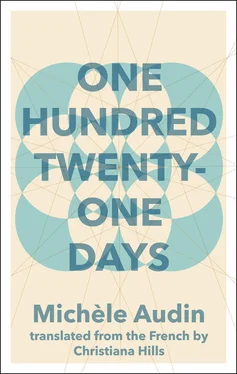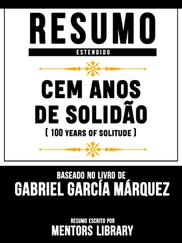Going clockwise around the metal openwork table, one sees a teenage girl, then two men and two women, all four middle-aged. All of them are looking towards the camera, which means that some of them (the girl and one of the women) had to turn towards the photographer. Between the girl and this woman, in the foreground, is an empty chair. A clay tobacco jar has been placed at the center of the table. The men have drinking glasses in front of them. The man sitting nearest to the girl is in the middle of serving himself from a near-empty bottle. His hand obscures the label, but the contents are almost certainly a pale-colored spirit, which could be kirsch.
To the right of the actual map (2005 edition) are five pictures (numbered and captioned) of places deemed by the little town’s tourist center as particularly interesting for visitors. The numbers on these pictures correspond to other (identical) numbers on the map itself. One of these places, the one marked with the number 4, is a pastry shop. Founded in 1858 (according to the caption), Korb & Schlag is located in a pink gabled house, with geraniums brightening up its windows, on the north side of the marketplace (Marktplatz), as shown in the photo.
A careful handwritten inscription (in German) on the back of the photograph identifies the seven people and the dog. The place (Humboldt-strasse, N.) and the date (July 6, 1943) are also indicated. The dog is named Stefi (a diminutive of Stefanie, which tells us the dog was female). The teenage girl is Charlotte Kürz, daughter of the mathematician Heinrich Kürz. Two light blonde braids tied with white ribbons frame her young face, which is a little large for her body. She is dressed in a dark skirt, white socks, and a white short-sleeved blouse, with a dark neckerchief worn as a tie and tightened at the neck with a braided leather kerchief slide. Her head is slightly tilted and she is smiling at the camera.
Picture number 1 shows a fountain located in the middle of the Marktplatz. The fountain bears the name Gretchen am Spinnrade, or “Margaret at the spinning wheel,” because of the little statue at the top that indeed represents a girl working at her spinning wheel. As the tourist center’s commentary explains, according to an old tradition, before passing their exams or leaving for the army, the students of the University of N. must climb the fountain to plant a kiss on little Gretchen’s stone lips.
The girl in the photo is no more than fifteen or sixteen years old. The other individuals are all much older. The two men seated at the table, according to the inscription on the back, are Doktor (medical) Friedrich (the one pouring himself a drink) and Professor-Doktor von Apfeldorf. Both wear dark suit jackets, white collared shirts, and ties. Around von Apfeldorf’s left arm is an armband bearing a swastika. Behind them, one can distinguish the wall of a house and a window with a white frilled curtain and wooden shutters.
Number 2 on the map is Gustav-August University, founded in 1687 by Prince Gustav August and host to many renowned scholars since that time. The description is followed by a list of these scholars, in which one can recognize the names of the streets in the neighborhood where the 1943 photo was taken.
Another modern-day solution for learning about the individuals appearing in the photograph is the biographical dictionary of the University of N. (1991 edition). It identifies Ernst von Apfeldorf as “a historian specializing in the German Middle Ages.”
The two women in the photograph are Frau Kürz, mother of Charlotte Kürz and wife of Heinrich Kürz, and Frau von Apfeldorf, the historian’s wife. Both women are blonde. One wears a white blouse under a suit jacket, its neck open wide to reveal a pearl necklace. The other has a flowered dress and a gold cross necklace. Their smiles reveal dazzling teeth and the use of lipstick. Between the table and the bench where the two pipe smokers are seated, a little to the side, is a flag mast, of which the cord can be seen. The flag, if there is one, is outside of the camera’s scope. The two men seem to have been interrupted in the middle of a lively conversation. They have raised their eyes towards the camera. Above them hang the shadowy branches of a linden tree, whose trunk cannot be seen. Even the way they both pet the little dog attests to a certain level of closeness between then. The one on the left, closer to the table, is the host of this pleasant gathering: Gustav Tiedemann. He is smiling.
The biographical dictionary describes Gustav Tiedemann as a “college professor of biology” and points out that he directed the dissertation of Emil Schreiber, the famous German-American biologist.
On the map, not far from the marketplace, is a green patch representing Marienfriedhof, a little cemetery that looks more like a public park, with a blue pond. It is marked with the number 3. The tourist center’s commentary states that Marienfriedhof contains the tomb of Karl Ludwig Spankerfel, the famous mathematician and physician who died in 1815. Another old tradition dictates that foreign scholars invited to the University of N. be brought to Marienfriedhof to reflect on this tomb.
On the far right of the photograph, the man petting Stefi the dog is the French mathematician Christian Morfaust. The foreign scholar’s presence in the little town was probably the pretext for organizing this gathering. Morfaust wears a mask of black leather that hides the majority of his face and ties behind his ears, underneath the sides of his round eyeglasses. Like his friend Tiedemann, he sports a satisfied smile, clearly visible in spite of the pipe.
There is also the Kolloquium register. The huge hardbound register, in which, since 1888, the guests of the Mathematics Kolloquium of Gustav-August University have written summaries of their talks, shows little activity in 1943. Professor Morfaust, from the University of Paris, is the only foreigner to have written in the register since November 4, 1941 (the day Kirill Kristoff, from the University of Sofia, gave a talk on differential equations). Three German mathematicians visited in the meantime. Morfaust used violet ink to write both his name and the title, “On a Theorem of Spankerfel and Legendre.” His summary (originally in French) says:
We give the formal statement of a theorem on prime numbers, as written by Karl Ludwig Spankerfel in 1809. Adrien-Marie Legendre found a proof for it the following year. We return to this fine example of amicable scientific collaboration.
The talk summarized on the next page of the register dates from 1948.
On the map, number 5 is the N. Museum of Printing. This museum mainly contains engravings and antiquarian books (which are often rare as well). One of the engravings, whose artist is unknown, is reproduced on the map. In spite of the small size of this reproduction, one can recognize a classic character from German legends: a horned, cloven-hoofed demon, with circumflex eyebrows and a pointy beard. He is seated in a public square in front of some gabled houses with his sharp chin resting on his fist and one leg crossed, and he appears to be in conversation with a little dog.
Two people are missing from the photograph: Heinrich Kürz and Frau Tiedemann. The empty chair is probably where the man or woman taking the photograph was sitting. If the photographer was Kürz, the mathematician who invited Morfaust to N., then Frau Tiedemann was busy in her kitchen, and the photo would have been taken without waiting for (or thinking of) her. If it was Frau Tiedemann, then Kürz wasn’t there at all, but was rather called back to Berlin or elsewhere by his military obligations (decoding enemy messages, recruiting collaborators to the German war effort). In front of the empty chair, there is no drinking glass, which favors the second hypothesis. Nothing allows for a definite answer, in spite of the inscription on the back.
Читать дальше












